
Isolated and modernized African tribes
AFRICA has been the last of the large continents to be invaded and explored by our modern civilization. It has one of the largest native populations still living in accordance with inherited traditions. Accordingly, it provides a particularly favorable field for studying primitive racial stocks.
This study of primitive racial stocks, with the exception of some Indian groups, has been largely concerned with people living under physical conditions quite different from those which obtain in the central area of a large continent.
Sea foods are within reach of the inhabitants of islands and coastal. regions regardless of latitude. The inhabitants of the interior of a continent, however, have not access to liberal supplies of various forms of animal life of the sea. It was important, therefore, in the interest of the inhabitants of the United States, Canada, Europe, and other large continental interiors, to study primitive people living under environments similar to theirs. Africa is one of the few countries that can provide both primitive living conditions and the modern life of the plains and plateau country in the interior. The great plateau of eastern and central Africa has nurtured a score of tribes with superb physiques and much accumulated wisdom. We are concerned to know how they have accomplished this, and whether they or any other people can survive in that environment after adopting the formulas of our modern civilizations. Considering that the most universal scourge of modern civilization is dental caries, though it is only one of its many degenerative processes, it is important that we study these people to note how they have solved the major problems of living in so severe and disciplining an environment as provided in Africa.
This was done during the summer of 1935. Our route took us through the Red Sea and down the Indian Ocean to enter the African continent at Mombasa below the equator and then across Kenya and Uganda into Eastern Belgian Congo, and thence about 4,000 miles down the long stretch of the Nile through Sudan to the modernized civilization of Egypt. This journey covered most of the country around Ethiopia and gave us contact with several of the most primitive racial stocks of that country. These people are accordingly the neighbors of the Abyssinians or Ethiopians. Since the various tribes speak different languages and are under different governments, it was necessary to organize our safari in connection with the local government officials in the different districts.

During these journeys in Africa which covered about 6,000 miles, we came in contact with about thirty different tribes. Special attention was given to the foods, samples of which were obtained for chemical analysis. Over 2,500 negatives were made and developed in the field. If any one impression of our experiences were to be selected as particularly vivid, it would be the contrast between the health and ruggedness of the primitives in general and that of the foreigners who have entered their country. That their superior ruggedness was not racial became evident when through contact with modern civilizations degenerative processes developed. Very few of the many Europeans with whom we came in contact had lived in central Africa for as much as two years without serious illness or distinct evidence of physical stress. That the cause was not the severity of the climate, but something related to the methods of living, was soon apparent. In all the districts it was recognized and expected that the foreigners must plan to spend a portion of every few years or every year outside that environment if they would keep well. Children born in that country to Europeans were generally expected to spend several of their growing years in Europe or America if they would build even relatively normal bodies.
One exacting condition of the environment that we encountered was the constant exposure to disease. Dysentery epidemics were so severe and frequent that we scarcely allowed ourselves to eat any food that had not been cooked or that we had not peeled ourselves. In general, it was necessary to boil all drinking water. We dared not allow our bare feet to touch a floor of the ground for fear of jiggers which burrow into the skin of the feet. Scarcely ever when below 6,000 feet were we safe after sundown to step from behind mosquito netting or to go out without thorough protection against the malaria pests. These malaria mosquitoes which include many varieties are largely night feeders. They were thought to come out soon after sundown. We were advised that the most dangerous places for becoming infected were the public eating houses, since the mosquitoes hide under the tables and attack the diner's ankles if they are not adequately protected. We rigidly followed the precaution of providing adequate protection against these pests. Disease-carrying ticks were so abundant in the grass and shrubbery that we had to be on guard constantly to remove them from our clothing before they buried themselves in our flesh. They were often carriers of very severe fevers. We had to be most careful not to touch the hides with which the natives protected their bodies from the cold at night and from the sun in the daytime without thorough sterilization following any contact. There was grave danger from the lice that infected the hair of the hides. We dared not enter several districts because of the dreaded tsetse fly and the sleeping sickness it carries. One wonders at the apparent health of the natives until he learns of the unique immunity they have developed and which is largely transmitted to the offspring. In several districts we were told that practically every living native had had typhus fever and was immune, though the lice from their bodies could transmit the disease. One also wonders why people with such resistance to disease are not able to combat the degenerative diseases of modern civilization. When they adopt modern civilization they then become susceptible to several of our modern degenerative processes, including tooth decay.
Dr. Anderson who is in charge of a splendid government hospital in Kenya, assured me that in several years of service among the primitive people of that district he had observed that they did not suffer from appendicitis, gall bladder trouble, cystitis and duodenal ulcer. Malignancy was also very rare among the primitives.
It is of great significance that we studied six tribes in which there appeared to be not a single tooth attacked by dental caries nor a single malformed dental arch. Several other tribes were found with nearly complete immunity to dental caries. In thirteen tribes we did not meet a single individual with irregular teeth. Where the members of these same tribes had adopted modern civilization many cases of tooth decay were found. In the next generation following the adoption of the European dietaries dental arch deformities frequently developed.
We are concerned to know something of the origin of these people including the Ethiopians and to what extent racial ancestry has protected them. If we refer to an ethnographic map of African races we find there is evidence of a great movement northward from South Africa. These people had some things in common with the Melanesians and Polynesians of the South Pacific whom we studied the year previously. Their language carries some words of similar meaning. While there are many tribes existing today, it is of significance that they each possess some identifying characteristics of language, dress and food habits. Another great racial movement has apparently moved southward from Northern Africa. These tribes are of Hamitic origin and include Nilotic tribes and Abyssinians. The Nilotic tribes have a distinct physical pattern and mode of life. These great racial movements have met in the Upper Nile region of Eastern Africa near the equator, and have swayed back and forth with successive obliteration or absorption of those tribes that were least sturdy. The negro race occupied an area across Africa from the West to Central Africa. They were exposed to the aggression and oppression of these two great racial movements, resulting often in intermingling in various proportions of racial bloods. The Semitic race, chiefly Arabs, occupied Arabia and a great area in Northern Africa.
In this bird's eye view we are observing changes that have been in progress during many hundreds or thousands of years. The Arabs have been the principal slave dealers working in from the east coast of Africa. They have maintained their individuality without much blending except on the coast. They have not become an important part of the native stock of the interior. These primitive native stocks can be largely identified on the basis of their habits and methods of living. The Nilotic tribes have been chiefly herders of cattle and goats and have lived primarily on dairy products, including milk and blood, with some meat, and with a varying percentage of vegetable foods. It was most interesting to observe that in every instance these cattle people dominated the surrounding tribes. They were characterized by superb physical development, great bravery and a mental acumen that made it possible for them to dominate because of their superior intelligence. Among these Nilotic tribes the Masai forced their way farthest south and occupy a position between two of the great Bantu tribes, the Kikuyu and the Wakamba. Both of these latter tribes are primarily agricultural people.
Masai Tribe. The Masai are tall and strong. Fig. 39 shows a typical belle, also a Masai man who is much taller than our six-foot guide. It is interesting to study the methods of living and observe the accumulated wisdom of the Masai. They are reported to have known for over two hundred years that malaria was carried by mosquitoes, and further they have practiced exposing the members of their tribes who had been infected with syphilis by the Arabs to malaria to prevent the serious injuries resulting from the spirochetal infection. Yet modern medicine boasts of being the discoverers of this great principle of using malaria to prevent or relieve syphilitic infections of the spinal cord and brain.
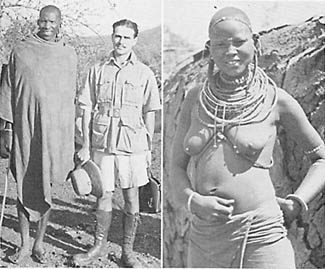
I saw the native Masai operating on their cattle with skill and knowledge. The Masai have no currency and all their transactions are made with cows or goats. A valuable cow was not eating properly, and I observed them taking a thorn out of the inside of her mouth. The surgical operation was done with a knife of their own making and tempered by pounding. The wound was treated by rubbing it with the ashes of a plant that acted as a very powerful styptic. Their knowledge of veterinary science is quite remarkable. I saw them treating a young cow that had failed to conceive. They apparently knew the cause and proceeded to treat her as modern veterinaries might do in order to overcome her difficulties. For their food throughout the centuries they have depended very largely on milk, meat and blood, reinforced with vegetables and fruits. They milk the cows daily and bleed the steers at regular intervals by a unique process. In Fig. 40 we see a native Masai with his bow and arrow, the latter tipped with a sharp knife which is guarded by a shoulder to determine the depth to which the arrow may enter the vein. If the animal is sufficiently tame, the blood is drawn while it is standing. If the animal is frightened it is quickly hobbled, as shown below. In this figure the stream of blood may be seen spurting from the jugular vein into a gourd which holds about a gallon. A torque is placed around the neck before the puncture is made. The animals did not even flinch when struck by the arrow, the operation is done so quickly and skillfully. When sufficient blood was drawn, the torque was removed and the blood immediately stopped flowing. A styptic made of ashes referred to above was used. This serves also to protect the wound from infection. The blood is defibrinated by whipping in the gourd. The fibrin is fried or cooked much as bacon or meat would be prepared. The defibrinated blood is used raw just as the milk is, except in smaller quantities. When available, each growing child receives a day's ration of blood as does each pregnant or lactating woman. Formerly, the warriors used this food exclusively. These three sources, milk, blood and meat provide them with liberal supplies of body-building minerals and the special vitamins, both fat-soluble and water soluble. Their estimate of a desirable dairy stock is based on quality not quantity. They judge the value of a cow for keeping in their herd by the length of time it takes her calf to stand on its feet and run after it is born, which is only a very few minutes. This is in striking contrast with the practice of our modern dairymen who are chiefly concerned with the quantity of milk and quantity of butter fat rather than with its value as a source of special factors for nutrition. Many of the calves of the modern high-production cows of civilized countries are not able to stand for many hours after birth, frequently twenty-four. This ability to stand is very important in a country infested with predatory animals; such as lions, leopards, hyenas, jackals and vultures.
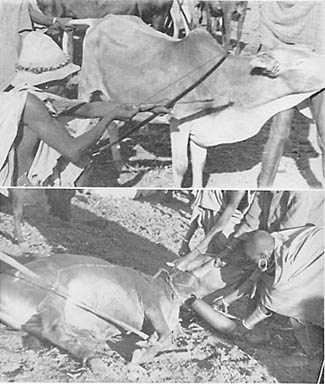
This reminded me of my experience in Alaska in studying the reindeer of the Eskimos. I was told that a reindeer calf could be dropped in a foot of snow and almost immediately it could run with such speed that the predatory animals, including wolves, could not catch it. And, moreover, that these fawns would go almost immediately after their birth with a herd on a stampede and never be knocked down.
The problem of combating the predatory animals, particularly the lions, calls for greater skill and bravery than is required by other tribes in Africa. The lions live on the large grazing animals, particularly the cattle, from which they select the strongest. In driving over the veldt we frequently saw one or two men or boys guarding an entire herd with only their spears. Their skill in killing a lion with a spear is one of the most superb of human achievements. I was interested to learn that they much prefer their locally made spears to those that are manufactured outside and brought in, because of their certainty that they will not break, will withstand straightening regardless of how much they are bent and because due to the process of manufacture will take a very sharp edge.
On one occasion, after we had been kept awake much of the night by the roaring of the lions and neighing of the zebras that were being attacked by the lions, we visited a Masai manyata nearby in the morning to learn that when they let their cattle and goats out of the corral of acacia thorns, three or four spearsmen went ahead in search of the lions that might be waiting to ambush the cattle. They apparently did not have the slightest fear. The lions evidentally had made a kill nearby. This the natives determined by the number of coyotes.
The heart and courage of these people has been largely broken by the action of the government in taking away their shields in order to prevent them pillaging the surrounding native tribes as formerly. They depended upon their shields to protect them from the arrows of the other tribes. The efforts to make agriculturists of these Masai people are not promising.
In a typical manyata the chief has several wives. Each one has a separate dwelling. Timber and shrubbery are so scarce in this vicinity that the dwellings are built of clay mixed with cow dung which is plastered over a framework of twigs. Many chiefs are over six feet in height.
The Masai live in a very extensive game preserve in which hundreds of thousands of grazing animals enjoy an existence protected from man since even the natives are not allowed to kill the animals as formerly. They seemed to be preserved for the numerous lions which occasionally become very bold since they have an abundance of food and no enemies. Recently the local government authorities found it necessary to shoot off eighty of the lions in a particular district because of their aggressiveness.
In the Masai tribe, a study of 2,516 teeth in eighty-eight individuals distributed through several widely separated manyatas showed only four individuals with caries. These had a total of ten carious teeth, or only 0.4 per cent of the teeth attacked by tooth decay.
Kikuyu Tribe, Kianzbu, Kenya. In contrast with the Masai, the Kikuyu tribe, which inhabits a district to the west and north of the Masai, are characterized by being primarily an agricultural people. Their chief articles of diet are sweet potatoes, corn, beans, and some bananas, millet, and Kafir corn, a variety of Indian millet. The women use special diets during gestation and lactation. The girls in this tribe, as in several others, are placed on a special diet for six months prior to marriage. They nurse their children for three harvests and precede each pregnancy with special feeding.
The Kikuyus are not as tall as the Masai and physically they are much less rugged. Like many of the central African tribes, they remove some lower incisors at the time these permanent teeth erupt. This custom is reported to have been established for the purpose of feeding the individuals in case of lock-jaw. One of the striking tribal customs is the making of large perforations in the ears in which they carry many metal ornaments. A typical Kikuyu woman is shown in Fig. 41 (upper right). Typical Kikuyu men are also shown in Fig. 41. Note their fine teeth and dental arches.
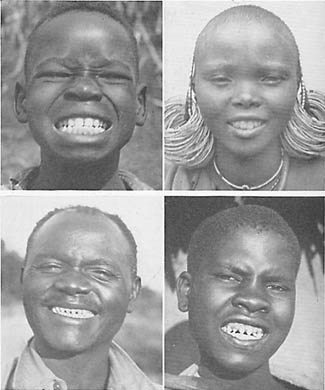
A study of 1,041 teeth in thirty-three individuals showed fifty-seven teeth with caries, or 5.5 per cent. These were 36.4 per cent of the individuals affected.
Much of the territory occupied by the Kikuyu tribes was formerly forest. Their practice has been to burn down a section of forest in order to get new lands for planting. As soon as the virgin fertility is exhausted, which is usually in three to five years, they burn down another section of forest. By this process they have largely denuded their section of Kenya of its timber. This has resulted in a great waste of building material. There are few stands of native forest within easy reach of transportation.
Wakamba Tribe, Kenya. The Wakamba tribe point their teeth as shown in Fig. 41. They occupy the territory to the east of the Masai, who in past centuries have driven themselves as a wedge between the Kikuyu and the Wakamba tribes. The Masai until checked carried on a relentless warfare, consisting largely of raids, in which they slaughtered the men and carried off the women and children and drove away the cattle or goats. The Wakambas are intellectually superior to the Kikuyus and have distinct artistic skill in the carving of art objects. They are mechanical and like machinery. Many of them have important positions in the shops of the Kenya and Uganda railway.
An examination of 1,112 teeth of thirty-seven individuals showed sixty-nine teeth with caries, or 6.2 per cent. Twenty-one and six-tenths per cent of the individuals studied had dental caries.
Jalou Tribe, Kenya. This tribe occupies the territory along Lake Victoria and Kisumu Bay. They are one of the most intelligent and physically excellent native tribes. They were studied in two groups, one at Maseno, and the other at Ogado.
The group studied at the Maseno school were boys ranging from about ten years to twenty-two, totaling about 190 in all. The principal of the school presented the boys in military formation for inspection. Through him as interpreter I asked that all boys who had ever had toothache hold up their hands, and nineteen did so. Of the nineteen only one individual was found to have caries; two of his teeth were involved, which, out of 546 teeth for these individuals, gives 0.4 per cent of the teeth with caries.
In the Ogada Mission a study of 258 teeth for ten individuals revealed no teeth affected with dental caries.
Jeannes School, Kenya. This school is located at Kabete. It is an institution where young married couples are trained in domestic science, agriculture, and similar subjects.
In 388 teeth of thirteen individuals, thirty-one teeth were found to have been attacked by dental caries, or 7.9 per cent. These were in six individuals.
Pumwani Mission School, Kenya. This is a native suburb of Nairobi, and there the people have come under the influence of recent European contact.
In an examination of 588 teeth of twenty-one individuals twenty-six teeth had caries, or 4.4 per cent.
C. M. S. School, Nukuru, Kenya. The children of this school belong to several tribes, chiefly Jalou. In a study of 312 teeth of eleven individuals, only one tooth was found to have been attacked by tooth decay, or 0.3 per cent.
Chewya at Kisurnu, Kenya. The natives of this district belong to the Maragoli tribe. They are very strong and physically well developed. They live within easy reach of Lake Victoria from which they obtain large quantities of fish which constitutes an important part of their diet, together with cereals and sweet potatoes.
A study of 552 teeth of nineteen individuals revealed only one tooth with dental caries, or 0.2 per cent.
Muhima Tribe or Anchola, Uganda. This tribe resides in southern Uganda. They, like the Masai, are primarily a cattle raising people and live on milk, blood and meat. The district in which they live is to the east of Lake Edward and the Mountains of the Moon. They constitute one of the very primitive and undisturbed groups. While the Masai raise chiefly the hump-backed cattle, the herds of this Muhima or Anchola tribe are characterized by their large wide-spread horns. Like the Masai, they are tall and courageous. They defend their herds and their families from lions and leopards with their primitive spears. Like the other primitive cattle people, they dominate the adjoining tribes.
In a study of 1,040 teeth of thirty-seven individuals, not a single tooth was found with dental caries. This tribe makes their huts of grass and sticks.
Watusi Tribe. This is a very interesting tribe living on the east of Lake Kivu, one of the headwaters of the West Nile in Ruanda which is a Belgian Protectorate. They are tall and athletic. Their faces differ markedly from those of other tribes, and they boast a very noble inheritance. According to legend, a Roman military expedition penetrated into central Africa at the time of Anthony and Cleopatra. A phalanx remained, refusing to return with the expedition. They took wives from the native tribes and passed laws that thereafter no marriage could take place outside their group. They have magnificent physiques. Many stand over six feet without shoes.
Several of the tribes neighboring Ethiopia are agriculturists and grow corn, beans, millet, sweet potatoes, bananas, Kafir corn, and other grains, as their chief articles of food. Physically they are not as well built as either the tribes using dairy products liberally or those using fish from the fresh water lakes and streams. They have been dominated because they possess less courage and resourcefulness.
The Government of Kenya has for several years sponsored an athletic contest among the various tribes, the test being one of strength for which they use a tug-of-war. One particular tribe has carried off the trophy repeatedly. This tribe resides on the east coast of Lake Victoria and lives very largely on fish. The members are powerful athletes and wonderful swimmers. They are said not to have been conquered in warfare when they could take the warfare to the water. One of their methods is to swim under water to the enemy's fleet and scuttle their boats. They fight with spears under water with marvelous skill. Their physiques are magnificent. In a group of 190 boys who had been gathered into a government school near the east coast of Lake Victoria only one boy was found with dental caries, and two of his teeth had been affected. The people dry the fish which are carried far inland.
Uganda which lies to the north and west of Lake Victoria and west of Kenya, is high and although on the equator, has an equitable climate with an abundance of native foods. Two crops per year are produced, and many varieties of bananas grow wild. The Buganda Tribe, Uganda, is the chief tribe of this region. Uganda has been called the Garden of Eden of Africa because of its abundance of plant foods, chiefly bananas and sweet potatoes, and because of its abundance of fresh water fish and animal life. The natives are thrifty and mentally superior to those of most other districts. They have a king and a native parliament which the British Government recognizes and entrusts with local administrative affairs. A typical group was studied in a mission at Masaka. An examination of 664 teeth of twenty-one individuals revealed only three teeth with caries, or 0.4 per cent.
West Nile Laborers from the Belgian Congo. The West Nile Laborers studied at Masaka represent a very strong and dependable group. They come from districts north of Lake Albert in Belgian Congo. They are much sought for in industrial enterprises and are often moved in groups for a considerable distance.
A study of 984 teeth of thirty-one individuals revealed that only three teeth had ever been attacked by tooth decay, or 0.3 per cent. Only one individual had dental caries.
As one travels down the West Nile and later along the western border of Ethiopia many unique tribes are met. A typical negroid type of the upper Nile region is shown in Fig. 42. Members of these tribes wear little or no clothing. They have splendid physiques and high immunity to dental caries.
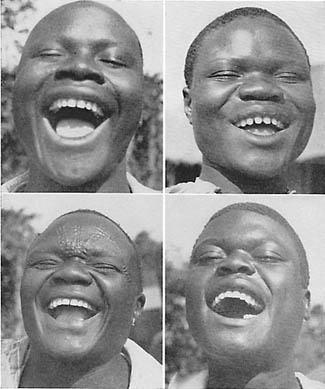
After the confluence of the White Nile and West Nile, the former draining Lake Victoria and the Uganda lakes through Uganda, and the latter, Lakes Kivu, Edwards and Albert and eastern Belgian Congo, the volume of water moving northward is very large. A unique obstruction to navigation has developed due to the fact that the Nile runs underground for a considerable distance. In this district vegetation is rank and prolific, including large quantities of water plants which form islands that are often attached temporarily to the shore. The water carries large quantities of alluvia which furnish an abundance of nutriment to the floating plant life. Accordingly, in many of these floating islands a large quantity of soil is enmeshed in the plant roots. At some period in the past the river became bridged across in upper Sudan near its southern border. With the progressive addition of new material a large natural bridge has been raised on which trees are now growing, and across which are elephant trails. This and a series of rapids require a detour of over a hundred miles.
The elephants are so plentiful in this district that both in Uganda and Sudan the governments have been required to send in special hunters to reduce the herds. In one district in Uganda two hundred were said to have been slaughtered. They are very destructive to banana plantations. They break the banana trees over or pull them up by the roots and eat the succulent heart as well as the fruits. In a night a herd may destroy an entire plantation. The only people in the districts who are permitted to kill the elephants without license are the pygmies. They are also the only ones not required to pay a head tax. There are many tribes of them in the great forest area in Belgian Congo and Uganda. Their skill with spears is remarkable and they are able to kill an elephant while the animal remains unaware of his danger. It takes them one to two days to hamstring an elephant by working stealthily from behind, always keeping out of the elephant's sight. Although an elephant can scent a human for a long distance, these pygmies can disguise themselves so completely that the elephant is unaware of their presence. After disabling him by cutting the tendons of both hind legs, they attack him openly and, while one attracts his attention, the other slowly but progressively hacks off his trunk. In this manner he bleeds to death. They are particularly fond of elephant meat and a slaughter means a great feast. While we were in one of the pygmy colonies two of them brought in the tusks of an elephant they had just killed. We had the rare opportunity of witnessing the celebration in the colony, which included the special reproduction in pantomime of the attack and method of killing the elephant. The pygmy mother of these two men is shown in Fig. 43 (lower half). It will be noticed that she is a full head shorter than Mrs. Price, who is five feet three inches tall. This rugged, though small, woman is the mother of five grown men, two of whom are shown in Fig. 43 with the tusks of the elephant. Note their homemade spears. As marksmen with bows and arrows and as trappers, these pygmies have wonderful skill. Their arrows are tipped with iron of their own manufacture and have receptacles for carrying drugs which they extract from plants. These drugs temporarily paralyze the animals. For animals which they wish to destroy the arrows carry a poison which rapidly produces death. The home life of the pygmies in the forest is often filled with danger. Just before our arrival two babies had been carried off by a leopard. This stealthy night prowler is one of the most difficult animals to combat and probably has been one of the reasons the pygmies build cabins in the trees. Ordinarily their homes are built on the ground in a little clearing in the big forest. They consist of low shelters covered with banana leaves and other plants, built over a frame work. The native missionary dispensed our gift of salt which is one of their most prized gifts. They put on a dance for us.
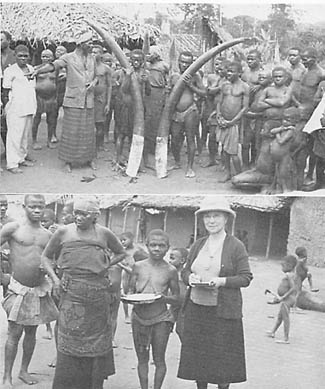
Pygmies, Ituru Forest, Belgian Congo. These people are said to have originally lived in the trees and they were exceedingly shy and difficult to contact. We were taken to several of their villages in the heart of the dense Ituru forest. We found them very well disposed through the confidence that has been established by the mission workers. Their shyness, however, together with the difficulty of making them understand through two transfers of languages, made an examination of their teeth very difficult.
A study of 352 teeth of twelve individuals revealed eight teeth had been attacked by tooth decay, or 2.2 per cent.
The native tribes of Africa have depended to a great extent on fresh water fish from the numerous lakes and rivers for certain of their essential food factors. After being dried in the sun these fish are carried long distances into the interior. The Nile perch grows frequently to a weight of 150 pounds. The natives of Africa know that certain insects are very rich in special food values at certain seasons, also that their eggs are valuable foods. A fly that hatches in enormous quantities in Lake Victoria is gathered and used fresh and dried for storage. They also use ant eggs and ants.
Nyankunde Mission, Iruinu, Belgian Congo. This group is made up of members of the Bahema, Babira, Alur and Balendu tribes. We will consider the representatives of these different tribes collectively since they live largely on a common dietary consisting chiefly of cereals. Only the Bahemas of this group have small herds of cattle. Some of the others have a few goats. This district is located southwest of Lake Albert.
A study of 6,461 teeth of 217 individuals revealed 390 teeth with dental caries, or 6 per cent. Thirty-eight and seven-tenths per cent of the individuals suffered from dental caries.
Bogora Mission, Belgian Congo. This mission is located west of Lake Albert and includes members of the Bahema and Balendu tribes. While the Bahema tribe originally lived very largely on cattle products, milk, blood and meat, in this district, the herds were small and they were using a considerable quantity of cereals, chiefly corn and beans, some sweet potatoes and bananas. These latter were the chief foods of the other tribes, in addition to goats' milk.
An examination of 2,196 teeth of seventy-seven individuals revealed 160 teeth with caries, or 7.2 per cent. Fifty-three per cent of the individuals had caries.
Kasenyi Port, Lake Albert, Belgian Congo. These natives were members of several tribes surrounding this district who were for the most part temporary residents as laborers. The people had been living largely on a cereal diet and now during their temporary residence at the port had had fish.
An examination of 1,940 teeth of sixty-three individuals revealed 120 teeth with dental caries, or 6.1 per cent of the teeth. Fifty and eighttenths per cent of the individuals had dental caries.
Wanande Tribe, Belgian Congo. This tribe is located at Lubero in Belgian Congo. Their diet consists largely of bananas, sweet potatoes, cereals and goats' milk.
In an examination of 368 teeth of thirteen individuals, there were eight teeth with caries, or 2.2 per cent. Fifteen and four-tenths per cent of the individuals were affected.
Baitu Tribe, Nyunge, Ruanda, Belgian Protectorate. This district lies south of Uganda and east of Belgian Congo proper, northwest of Tanganyika. It lies just east of Lake Kivu. When we learn that Lake Kivu was only discovered in 1894, even though it is one of the important sources of the Nile waters, we realize the primitiveness of the people of this and adjoining districts. This group lives largely on dairy products from cattle and goats, together with sweet potatoes, cereals and bananas.
In a study of 364 teeth of thirteen individuals, not a single tooth was found to have been attacked by dental caries.
Native Hotel Staff at Goina, Belgian Congo. This group consisted of the inside and outside servants of a tourist hotel on Lake Kivu.
An examination of 320 teeth of ten individuals revealed twenty teeth with caries, or 6.3 per cent. It is significant that all of these carious teeth were in the mouth of one individual, the cook. The others all boarded themselves and lived on native diets. The cook used European foods.
Where the members of the African tribes had attached themselves to coffee plantations aad were provided with the imported foods of white flour, sugar, polished rice and canned goods, tooth decay became rampant. This is typically illustrated in Fig. 44.
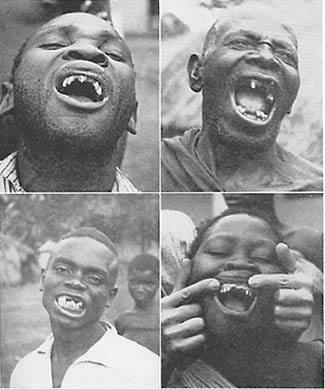
Anglo-Egyptian Sudan has an area approximately one-third that of the United States. It is traversed throughout its length from south to north by the Nile. There are several tribes living along this great waterway, which are of special interest now owing to their close proximity to Ethiopia. There are wonderful hunters and warriors among them. In hunting they use their long-bladed spears almost entirely. The shores of the Nile for nearly a thousand miles in this district are lined with papyrus and other water plants to a depth of from several hundred yards to a few miles. Back of this area the land rises and provides excellent pasturage for the grazing cattle. These tribes, therefore, use milk, blood and meat from cattle and large quantities of animal life from the Nile River. Some of the tribes are very tall, particularly the Neurs. The women are often six feet or over, and the men seven feet, some of them reaching seven and a half feet in height. I was particularly interested in their food habits both because of their high immunity to dental caries which approximated one hundred per cent, and because of their physical development. I learned that they have a belief which to them is their religion, namely, that every man and woman has a soul which resides in the liver and that a man's character and physical growth depend upon how well he feeds that soul by eating the livers of animals. The liver is so sacred that it may not be touched by human hands. It is accordingly always handled with their spear or saber, or with specially prepared forked sticks. It is eaten both raw and cooked.
Many of these tribes, like the Neurs, wear no clothing and decorate their bodies with various designs, some of them representing strings of beads produced by putting foreign substances under the skin in definite order. They have maintained a particularly bitter warfare against the Arab slave dealers who have come across from the Red Sea coast to carry off the women and children. In isolated districts even to this day they are suspicious of foreigners. We were told that in one district adjoining Ethiopia all light skinned people are in danger and cannot safely enter that territory without a military escort.
Terraizeka, Upper Nile, Sudan. These people are tall and live largely on fish and other animal life. This part of Sudan consists of many districts of great marshland called the sudd. It is covered with rank papyrus to the height of fifteen to thirty feet. This jungle of rank marsh growth swarms with a wide variety of animal life, large and small.
An examination of 548 teeth of eighteen individuals revealed that not a single tooth had been attacked by dental caries, or 100 per cent immunity.
Neurs, Malakal, Sudan. The Neurs at Malakal on the Nile River are a unique tribe because of their remarkable stature. Many of the women are six feet tall and the men range from six feet to seven and a half feet in height. Their food consists very largely of animal life of the Nile, dairy products, milk and blood from the herds.
A study of 1,268 teeth of thirty-nine individuals revealed only six teeth with dental caries, or 0.5 per cent. Only three individuals had caries, or 7.7 per cent.
Dinkas, Jebelein, Sudan. This tribe lives on the Nile. Its members are not as tall as the Neurs. They are physically better proportioned and have greater strength. They use fish from the Nile and cereals for their diet. They decorate their bodies profusely with scars.
An examination of 592 teeth of twenty-two individuals revealed only one tooth with caries, or 0.2 per cent.
Arab Schools at Khartoum and Omdurman, Sudan. The Arabs are the chief occupants of the territory of Northern Sudan. Omdurman on the west bank of the White Nile opposite Khartoum is the largest purely Arab city in the world. It has been but slightly influenced by modern civilization. Khartoum, on the contrary, just across the river from Omdurman and the capital of Anglo-Egyptian Sudan, has districts which are typically modern. These include the government offices and administration organization. The Arab section of Khartoum has been definitely influenced by contact with the Europeans. This makes possible a comparative study of similar groups in the two cities-modernized Khartoum and primitive Omdurman.
A study of 1,284 teeth of fifty-two individuals in an Arab school at Khartoum revealed that 59 teeth or 4.7 per cent had been attacked by dental caries, or 44.2 per cent of the individuals studied.
In Omdurman a study of 744 teeth in thirty-one individuals, revealed only nine teeth that had been attacked by tooth decay, or 1.2 per cent. In this group only two or 6.4 per cent of the individuals had dental caries.
The groups examined were selected with the assistance of the government officials and consisted of the higher grade pupils in two advanced native schools, one in Khartoum and one in Omdurman.
It is of interest that of the two boys in the Arab school at Omdurman with dental caries one was the son of a rich merchant and used liberally sweets and European foods.
Native Hospital, Khartoum, Sudan. The individuals studied in this institution were from quite remote areas distributed through Sudan. Some had traveled many days on camels to obtain the help that the hospital provided.
A study of 288 teeth of ten individuals revealed that thirteen had been attacked by tooth decay, or 4.5 per cent.
Ikhlas School, Cairo, Egypt. This is a native school in which the individuals are comparable in many respects to those in the native schools at Khartoum and Omdurman. Their nutrition is highly modernized by living in a modern city.
A study of 2,092 teeth of eighty-five individuals revealed that 353 teeth or 12.1 per cent had been attacked by tooth decay. Seventy-five per cent of the individuals of this group had dental caries.
The total number of teeth examined in the preceding groups was 28,438. Of this number, 1,346 were found with dental caries or 4.7 per cent. This represents a total of 1,002 individuals examined, of whom 300 had one or more carious teeth, or had lost teeth by caries, making 29.9 per cent of the individuals with dental caries. Of this total number of individuals studied in twenty-seven groups, there were several groups with practically complete immunity to dental caries, while other groups had relatively high incidence of that disease.
Facial and Dental Arch Deformities. The purpose of these studies has included the obtaining of data which will throw light also on the etiology of deformities of the dental arches and face, including irregularity of position of the teeth.
A marked variation of the incidence of irregularities was found in the different tribes. This variation could be directly associated with the nutrition rather than with the tribal pattern. The lowest percentage of irregularity occurred in the tribes living very largely on dairy products and marine life. For example, among the Masai living on milk, blood and meat, only 3.4 per cent had irregularities. Among the Kikuyu and Wakamba, 18.2 and 18.9 per cent respectively had irregularities. These peap!e were largely agriculturists living primarily on vegetable foods. In the native Arab school at Omdurman, among the pupils living almost entirely according to the native customs of selection and preparation of foods, 6.4 per cent had irregularities, while in the native school at modernized Khartoum 17 per cent had irregularities. In the Ikhlas school at Cairo, under modern influence, 16.5 per cent had irregularities. In the native hospital at Khartoum, 70 per cent had irregularities. In the Pygmy group 33.3 per cent had irregularities, and among the grain eaters of the west Nile, 25.5 per cent had irregularities. The Jeannes School had 46.1 per cent and the Ogada mission 30 per cent.
While the primitive racial stocks of Africa developed normal facial and dental arch forms when on their native foods, several characteristic types of deformity frequently developed in the children of the modernized groups. One of the simplest forms, and one which corresponds with a very common deformity pattern in the United States, involves the dropping inward of the laterals with narrowing of the upper arch making the incisors appear abnormally prominent and crowding the cuspids outside the line of the arch. Typical illustrations of this are shown in Fig. 45. Where the nutritional deficiency is very severe, as at Mombasa on the coast, more severe changes in facial form are found.
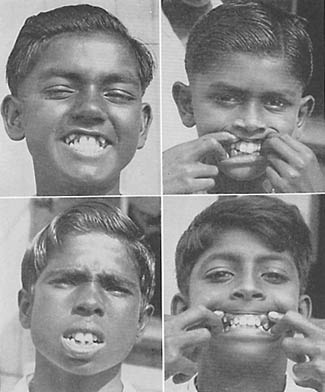
Among the deformity patterns a lack of development forward of the middle third of the face or of the lower third of the face often appeared in the more highly modernized groups. An illustration of the former is seen in Fig. 46 (upper left), and of the latter in Fig. 46 (lower left and right). In the girl at the upper left, the upper arch tends to go inside the lower arch all around. This girl is of the first generation, in a mission in Nairobi, following the adoption of the modernized foods by the parents.
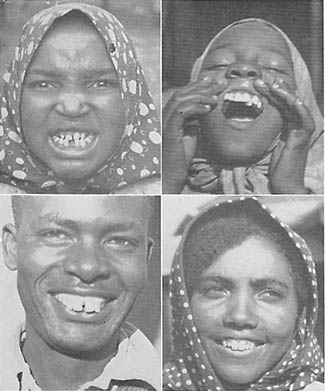
A more extreme and severe type of facial change involves an abnormal narrowing with marked distortion of both upper and lower arches. This is shown typically in Fig. 47.
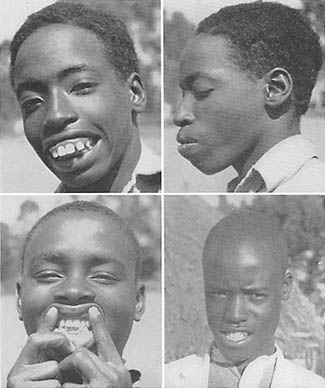
These extreme deformities often produce facial expressions that are suggestive of the faces of some of the monkeys. This is illustrated by the three boys shown with the monkey in Fig. 48.
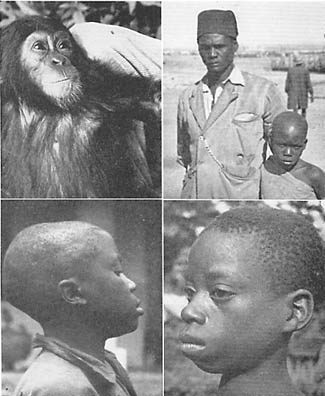
The Arabs in several districts use camels' milk extensively. It is nutritious, and in much of the desert country constitutes the mainstay of the nomads for months at a time. The primitive Arabs studied had fine dental arches with very little deformity. Even the horses ridden by the Arab chiefs in moving their camel herds across the desert are often dependent, sometimes for as long as three months, upon the milk of the camels for their nutrition. Typical Arab faces and a camel caravan at rest are shown in Fig. 49. The primitive Arab girls have splendidly developed faces and fine dental arches. Their natural beauty, however, is rapidly lost with modernization, as illustrated in Fig. 50.
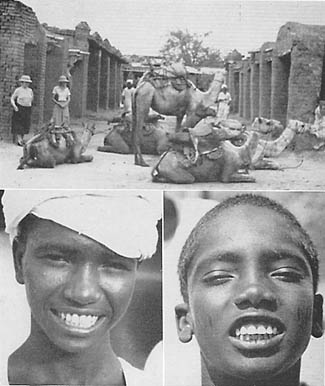
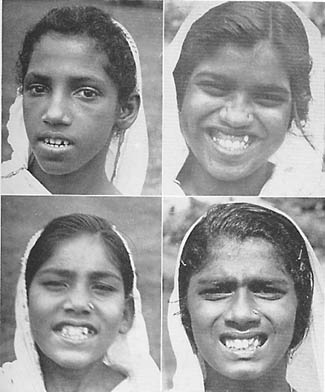
Dr. Hrdlicka has called attention to the occasional development in several racial stocks of individuals who travel on all fours instead of upright. I saw several individuals of this type in Africa scooting around about as rapidly as the dogs. They were, accordingly, difficult to photograph. Two are shown in Fig. 51.
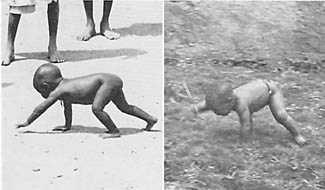
While slavery of the old form no longer exists in the so-called civilized countries, in its new form it is a most tragic reality for many of the people. Taxes and the new order of living make many demands. For many of these primitive tribes a new suit of clothes could formerly be had every day with no more trouble than cutting a new banana leaf. With the new order they are requested to cover their bodies with clothing. Cloth of all kinds including the poorest cotton has to be imported. They must pay an excessive charge due to the long transportation cost for the imported goods, a charge which often exceeds the original cost in the European or American markets by several fold. In order to pay their head tax they are frequently required to carry such products as can be used by the government officials, chiefly foods, over long distances and for part of each year. These foods are often those which not only the adults, but particularly the growing children sorely need for providing body growth and repair. This naturally has produced a current of acute unrest and a chafing under the foreign domination.
As we encircled Ethiopia we found the natives not only aware of what was going on in that border country, but deeply concerned regarding the outcome. From their temper and sympathetic attitude for the oppressed Ethiopians, it would not be surprising if sympathizers pass over the border into that country to support their crushed neighbors. The problem is accordingly very much larger than the interest of some particular foreign power. It deals directly with the future course of events and the attitude of the African natives in general toward foreign domination. The native African is not only chafing under the taxation by foreign overlords, but is conscious that his race becomes blighted when met by our modern civilization. I found them well aware of the fact that those of their tribes who had adopted European methods of living and foods not only developed rampant tooth decay, but other degenerative processes.
In one of the most efficiently organized mission schools that we found in Africa, the principal asked me to help them solve a serious problem. He said there was no single question asked them so often by the native boys in their school as why it is that those families that have grown up in the mission or government schools were physically not so strong as those families who had never been in contact with the mission or government schools. These young men were thinking. I was even asked several times by them whether or not I thought that the native Africans must go the way of the Red Indians of America.
The happiness of the people in their homes and community life is everywhere very striking. A mining prospector who had spent two decades studying the mineral deposits of Uganda was quoted to me as stating that if he could have the heaven of his choice in which to spend all eternity it would be to live in Uganda as the natives of Uganda had lived before modern civilization came to it.
While inter-tribal warfare has largely ceased, a new scourge is upon them, namely the scourge which comes with modern civilization. As in the primitive racial stocks previously studied and reported, we found that modernizing forces were often associated with a very marked increase of the death rate over the birth rate. In some districts in Africa a marked degeneration is taking place. Geoffrey Gorer in his book, "Africa Dances," (1) which was written after making studies in West Africa, discusses this problem at length.
He quotes figures given by Marcel Sauvage (2) in his article on French Equatorial Africa: "'In 1911 French Equatorial Africa had twenty million negro inhabitants; in 1921 there were seven and a half million; in 1931 there were two and a half million.'"
He states regarding the quotation: "These figures were given in a responsible French conservative paper and have not been denied." Major Browne, a high official of the British Government Administrative Department of Kenya, with long experience, states in the closing paragraph of his book entitled, "The Vanishing Tribes of Kenya," (3) the following:
It must also be remembered that the "blessings of civilization" are not in practice by any means as obvious as some simple-minded folk would like to believe. It can be said with fair accuracy that among the tribes with which we have been dealing there is, in their uncontaminated society, no pauperism, no paid prostitution, very little serious drunkenness, and on the whole astonishingly little crime; while practically everyone has enough to eat, sufficient clothing, and an adequate dwelling, according to the primitive native standard. Of what civilized community can as much be said?
Civilizations have been rising and falling not only through all the period of recorded history, but long before as evidenced by archeological findings. If we think of Nature's calendar as one in which centuries are days and civilizations are years, the part current events are playing in the history of a great continent like Africa may be mere incidents.
This much we do know that throughout the world some remnants of several primitive racial stocks have persisted to this day even in very exacting environments and only by such could they have been protected.
In my studies of these several racial stocks I find that it is not accident but accumulated wisdom regarding foods that lies behind their physical excellence and freedom from our modern degenerative processes, and, further, that on various sides of our world the primitive people know many of the things that are essential for life-things that our modern civilizations apparently do not know. These are the fundamental truths of life that have put them in harmony with Nature through obeying her nutritional laws. Whence this wisdom? Was there in the distant past a world civilization that was better attuned to Nature's laws and have these remnants retained that knowledge? If this is not the explanation, it must be that these various primitive racial stocks have been able through a superior skill in interpreting cause and effect, to determine for themselves what foods in their environment are best for producing human bodies with a maximum of physical fitness and resistance to degeneration.
Primitive native races of eastern and central Africa have in their native state a very high immunity to dental caries, ranging from 0 to less than 1 per cent of the teeth affected for many of the tribes. Where modernized, however, the incidence increased to 12.1 per cent.
In the matter of facial deformity thirteen tribes out of twenty-seven studied presented so high a standard of excellence that not a single individual in the group was found with deformed dental arches.
Their nutrition varied according to their location, but always provided an adequate quantity of body-building and repairing material, even though much effort was required to obtain some of the essential food factors. Many tribes practiced feeding girls special foods for an extended period before marriage. Spacing of children was provided by a system of plural wives.
References
Next
Table of Contents
Back to the Small Farms Library